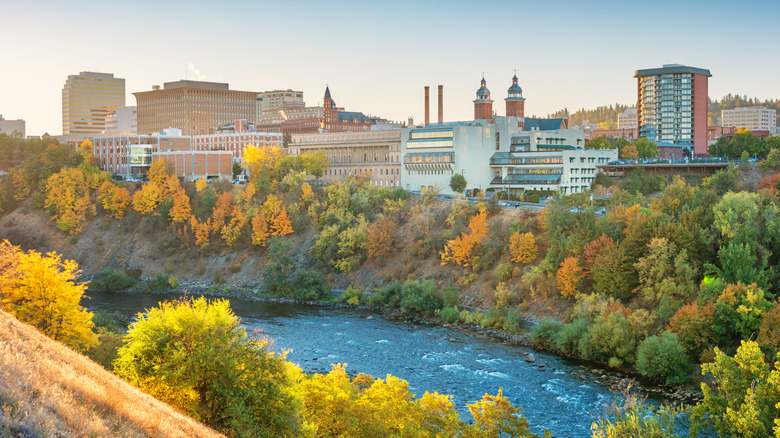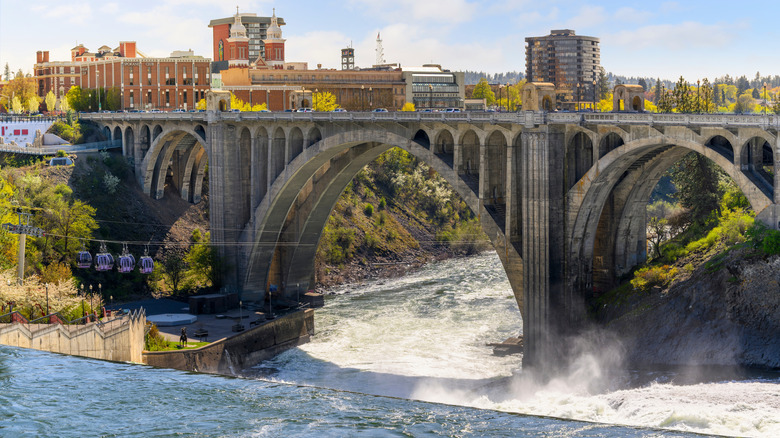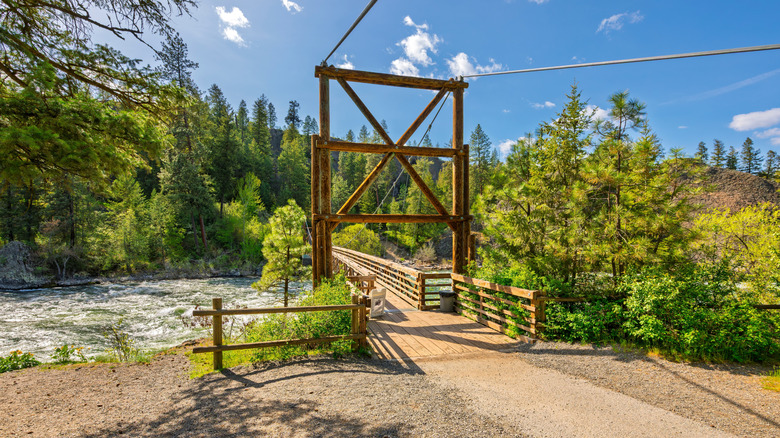The 'River City' Fuses Washington Waterfalls, Scenic Trails, And One Of America's Most Iconic Urban Parks
Spokane, Washington's second-largest city, is one of the most underrated cities across America. Travelers tend to overlook it on their way to the state's more famous city, Seattle. However, Spokane, known as the "River City," has just as many (albeit different) charms. From waterfalls in the middle of the city, to a well-preserved historic center, to world-class parks, to year-round recreational opportunities, Spokane shines. Given the fact that it has its own airport, Spokane International Airport (GEG), it's easy to visit. Or you could fly into Seattle-Tacoma International Airport, an easy four-hour drive.
Spokane is named after the local Spokane tribe, whose name means "Children of the Sun," appropriate for a tribe that has inhabited the sunniest part of Washington for generations. Spokane gets its nickname, River City, from the Spokane River, which winds its way right through the city center and features Spokane Falls, the largest urban waterfall in the country. The local Spokane Tribe, who named the falls "Stluputqu," or "swift water," used to gather here annually for sacred festivals. Later, the falls were harnessed for hydroelectric power. In 1974, the area around the falls was revitalized for the upcoming World Fair.
The falls can be viewed from all over Spokane. You can get a great view from the two pedestrian suspension bridges that cross over the upper and lower falls. A Place of Truths is the newest viewing point for the falls, built by the local Colville tribes to honor Spokane's long indigenous heritage. Huntington Park is one of the most spectacular viewing points, with paths that take you right to the base. Or you could head to the Monroe Street Bridge and visit the "viewing nest" under the bridge. From there, you can hop on the Centennial Trail, which goes clear to Idaho.
Take in the views from iconic urban Riverfront Park
One of the best ways to see the Spokane Falls, though, is from iconic Riverfront Park. Voted one of America's most beautiful urban parks by none other than National Geographic, Riverfront Park was an old railway yard that was turned into a park for the World Fair Expo '74. That was the year it was hosted by Spokane (the smallest city to ever host a world fair). It's hard to imagine that this oasis in the heart of Spokane, which hosts year-round festivals and concerts, was a decrepit rail yard 50 years ago. Along with views of Spokane Falls, including from the Skyride Gondola, Riverfront Park is also home to several iconic Spokane landmarks.
One of these is the Looff Carrousel, one of the few remaining (and best-preserved) hand-carved carousels left in the country. The carousel features whimsically carved animals, from horses, to a giraffe, a tiger, and dragons. Then there's the "Garbage Goat," built for Expo '74 by a woman known as the "Welding Nun." This unique and fun metal sculpture is in the shape of a goat that, literally, eats your trash. Finally, there's perhaps the most iconic symbol of Riverfront Park, and even Spokane, and that's the "Childhood Express," a giant sculpture of a Radio Flyer Red Wagon. It's actually the biggest red wagon in the world. Children and adults alike can climb into the wagon and slide down the white handle.
Riverfront Park is gorgeous year-round. In the spring, the park bursts with purple blooms during the famous Lilac Festival (which is how Spokane got yet another nickname, the "Lilac City"). And in the fall, Riverfront City is the best place to see Spokane painted in fall foliage hues.
Live the River City's slogan: Near nature, near perfect
One of the highlights of Spokane is its proximity to nature, which is embodied in its slogan: "Near nature, near perfect." No less than 76 lakes are within an hour's drive from Spokane, including Spokane Lake and Idaho's pristine Lake Coeur d'Alene. And then there are rivers, creeks, state parks, and endless scenic trails, including the famous 40-mile-long, paved Centennial Trail that travels between Washington and Idaho. Centennial Trail technically begins in vast Riverside State Park, just 20 minutes northwest of Riverfront Park. Riverside State Park, in addition to being home to miles of hiking trails, is also a favorite for equestrians, bikers, and off-road vehicles.
Spokane is near the heart of Washington's agricultural country, which, thanks to the climate, is also Washington's wine country. Washington is second only to California when it comes to U.S. wine production, and their wine country is definitely one of the best under-the-radar wine regions in the country. Venture outside of Spokane to explore the vineyards, or sample wine right in town at one of the city's wine cellars, like Latah Creek or Barrister Winery.
If you're hoping to explore more of this "Near nature, near perfect" city, head to Spokane's Manito Park, home to a conservatory, playgrounds, themed gardens, paths, ponds, and even a cafe. Downtown Spokane itself is full of historical buildings. In fact, over half of the buildings are on the National Register of Historic Places. Most were built from 1890 on, after the Great Fire of 1889 destroyed most of the city (and had many residents sheltering on an island in the river). One notable exception is the 1879 Strong House, which is now one of the oldest buildings around.


